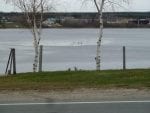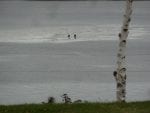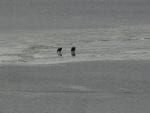Eagles waiting for a lunch.
New Brunswick’s endangered bald eagle population is soaring to heights unseen in decades, new estimates from the Department of Natural Resources show. There are between 110 and 145 breeding pairs of the massive bird, known for white feathers on its head and tail. That is double the 66 breeding pairs that were counted in the province a decade ago and a significant boost from the 12 pairs in 1980. Mark McGarrigle, a species at risk biologist at the Department of Natural Resources, said the bald eagle’s resurgence is not limited to New Brunswick.
“The results are encouraging and positive. We are seeing a positive trend, not just in the province but across North America,” McGarrigle said.
The Department of Natural Resources will use these new estimates as it identifies ways to help the species recover.
The department introduced a new Species at Risk Act in December that increased the number of endangered species to 60 from 16. Under the existing law, the bald eagle is designated on the regionally endangered list because it is not at risk nationally.
Now it is being joined by the harlequin duck, peregrine falcon and piping plover as the winged members of the new at-risk list.
Most bald eagles can be spotted nesting around freshwater lakes, rivers and estuaries and are often observed soaring overhead with their wingspan that can reach more than two metres.
- Big birds sitting on ice
- Looks like Bald Eagles
- Sure is!!!
Bald eagle nests are the largest nests of any bird species in North America.
‘It is a slow process.’—Mark McGarrigle, provincial biologist
The use of pesticides, and in particular DDT, has been blamed for the dramatic reduction of the bald eagle population on the continent.
McGarrigle said DDT contributed to eggshell thinning that led to the dramatic dropoff of the birds. The provincial biologist said it has taken some time for the rise in population after the pesticide prohibition in the 1970s.
“With the banning of the DDT, you may not have seen the population expansion until later on because it takes five to five and a half years from the time they are born to the time they are reproductively active,” McGarrigle said. “So it is a slow process.”
There are two bald eagle populations in the province, one that stays in New Brunswick year-round particularly in southwestern New Brunswick. The other group of eagles migrates to the southeastern United States in the winter.
As the population strengthens, McGarrigle said bald eagles have been spotted well outside their traditional areas, including in the northern reaches of the province and in Miramichi.
U.S. government removed bald eagle from endangered list
The U.S. government has crossed the bald eagle off its endangered list because of the burgeoning population. As a part of removing the bald eagle from the protected list, however, the U.S. Fish and Wildlife Service is require
d to monitor the population to make sure it does not drop again.
Unsatisfied with its own data on bald eagles, the Department of Natural Resources teamed up with the U.S. Fish and Wildlife Service to estimate the number of bald eagles in the province. Biologists from Maine and New Brunswick performed an aerial survey of specific parts of the province to estimate the number of breeding pairs of eagles over six days in April.
The biologists collected the new bald eagle numbers using GPS technology and hand-held computers. McGarrigle said the size of the bald eagles makes this new aerial counting method possible.
Although the bald eagles have been scratched off the U.S. endangered list, it is unlikely the bird will leave the New Brunswick list.
McGarrigle said there aren’t reliable figures on the number of bald eagles before the DDT spraying.
“DDT really became quite used in the 1950s onward. We don’t have reliable information on the population before that,” he said. “We don’t know what number would constitute a recovered population.”
Giv’er Miramichi is about “What’s up, what’s new, what’s happening”. We are focused on building people up, supporting one another and celebrating our successes.



